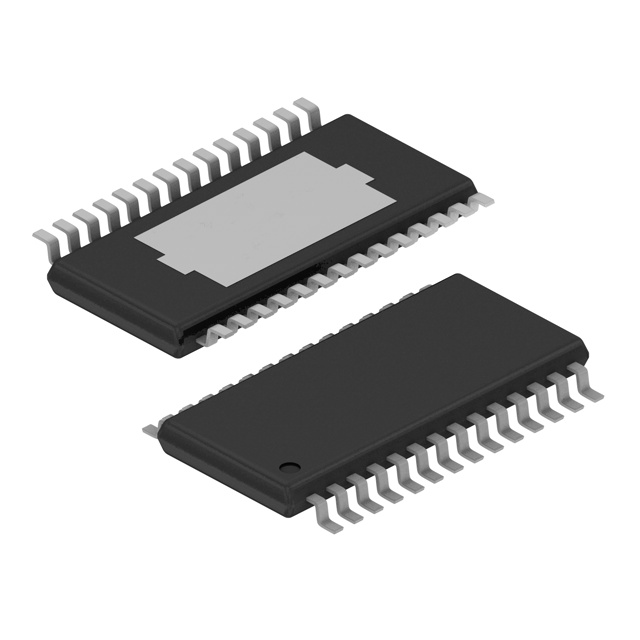TLC5940PWPG4
Product Overview
Category
The TLC5940PWPG4 belongs to the category of integrated circuits (ICs) specifically designed for LED lighting applications.
Use
This product is primarily used for controlling and driving LEDs in various lighting systems, such as displays, signs, automotive lighting, and architectural lighting.
Characteristics
- The TLC5940PWPG4 is a 16-channel constant current sink driver.
- It supports grayscale PWM (Pulse Width Modulation) control for each channel, allowing precise brightness adjustment.
- This IC has a built-in programmable grayscale control circuit, enabling smooth fading effects.
- It offers a wide range of grayscale steps, providing high-resolution control over LED brightness levels.
- The TLC5940PWPG4 operates with a supply voltage ranging from 3V to 5.5V, making it compatible with different power sources.
- It features a thermal shutdown protection mechanism to prevent overheating.
- This product is RoHS compliant, ensuring environmental friendliness.
Package and Quantity
The TLC5940PWPG4 is available in a TSSOP (Thin Shrink Small Outline Package) package. Each package contains one IC.
Specifications
- Supply Voltage: 3V to 5.5V
- Number of Channels: 16
- Grayscale Steps: 4096
- Maximum Output Current per Channel: 120 mA
- Operating Temperature Range: -40°C to +85°C
- Package Type: TSSOP
Pin Configuration
The TLC5940PWPG4 has a total of 28 pins. The pin configuration is as follows:
Pin 1: GND
Pin 2: OUT0
Pin 3: OUT1
...
Pin 27: OUT14
Pin 28: OUT15
Functional Features
- Precise control: The TLC5940PWPG4 allows individual control of each LED channel, enabling precise brightness adjustment.
- Grayscale control: With 4096 grayscale steps, this IC provides smooth fading effects and accurate color reproduction.
- Daisy-chain capability: Multiple TLC5940PWPG4 ICs can be connected in a daisy-chain configuration, expanding the number of controllable channels.
- Error detection: It incorporates error detection mechanisms to identify open or shorted LED connections, ensuring reliable operation.
Advantages
- High-resolution control over LED brightness levels.
- Smooth fading effects for visually appealing lighting applications.
- Daisy-chain capability simplifies system design and reduces wiring complexity.
- Error detection mechanism enhances reliability.
Disadvantages
- Limited to constant current sink applications.
- Requires external resistors for setting LED currents.
- Higher power dissipation compared to other LED driver ICs.
Working Principles
The TLC5940PWPG4 operates by receiving control signals from a microcontroller or other control devices. It uses these signals to generate PWM signals with varying duty cycles, controlling the LED brightness. The built-in grayscale control circuit ensures smooth transitions between different brightness levels.
Application Field Plans
The TLC5940PWPG4 finds extensive use in various lighting applications, including: 1. LED displays and signs 2. Automotive lighting systems 3. Architectural lighting installations 4. Stage and entertainment lighting 5. Backlighting for LCD panels
Alternative Models
For those seeking alternative options, the following LED driver ICs can be considered: 1. MAX7219 - 8-channel LED driver with serial interface. 2. TLC59116 - 16-channel constant current LED driver with I2C interface. 3. AS1130 - 132-channel LED driver with integrated matrix scanning capabilities.
These alternatives offer similar functionality and can be suitable replacements depending on specific requirements.
In conclusion, the TLC5940PWPG4 is a versatile LED driver IC designed for precise control and smooth fading effects in various lighting applications. Its high-resolution grayscale control, daisy-chain capability, and error detection mechanisms make it an excellent choice for demanding LED lighting projects.
Word Count: 537
Senaraikan 10 soalan dan jawapan biasa yang berkaitan dengan aplikasi TLC5940PWPG4 dalam penyelesaian teknikal
Sure! Here are 10 common questions and answers related to the application of TLC5940PWPG4 in technical solutions:
Q: What is the TLC5940PWPG4? A: The TLC5940PWPG4 is a 16-channel LED driver that can control brightness levels of individual LEDs or groups of LEDs.
Q: What is the maximum current output per channel of the TLC5940PWPG4? A: The TLC5940PWPG4 can provide a maximum current output of 120 mA per channel.
Q: Can the TLC5940PWPG4 be used with both common anode and common cathode LEDs? A: Yes, the TLC5940PWPG4 can be used with both common anode and common cathode LEDs.
Q: How many TLC5940PWPG4 chips can be daisy-chained together? A: Multiple TLC5940PWPG4 chips can be daisy-chained together to control a larger number of LEDs. The exact number depends on the specific application and requirements.
Q: What is the communication interface used by the TLC5940PWPG4? A: The TLC5940PWPG4 uses a serial interface (SPI) for communication with a microcontroller or other control device.
Q: Can the TLC5940PWPG4 handle high voltage inputs? A: No, the TLC5940PWPG4 operates at a low voltage range (typically 3.3V or 5V) and cannot directly handle high voltage inputs.
Q: Is it possible to dim the LEDs connected to the TLC5940PWPG4? A: Yes, the TLC5940PWPG4 supports grayscale PWM (Pulse Width Modulation), allowing for smooth dimming of LEDs.
Q: Can the TLC5940PWPG4 be used in automotive applications? A: Yes, the TLC5940PWPG4 is suitable for automotive applications as it can operate within the required temperature range and has built-in protection features.
Q: What is the maximum clock frequency supported by the TLC5940PWPG4? A: The TLC5940PWPG4 can support clock frequencies up to 30 MHz.
Q: Are there any evaluation boards or development kits available for the TLC5940PWPG4? A: Yes, Texas Instruments provides evaluation boards and development kits that can help with prototyping and testing the TLC5940PWPG4 in various applications.
Please note that these answers are general and may vary depending on the specific implementation and requirements of your technical solution.


